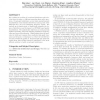99 search results - page 15 / 20 » Competitive interference-aware spectrum access in cognitive ... |
GLOBECOM
2010
IEEE
13 years 4 months ago
2010
IEEE
In a cognitive radio network, the full-spectrum is usually divided into multiple channels. However, due to the hardware and energy constraints, a cognitive user (also called second...
ICC
2007
IEEE
14 years 1 months ago
2007
IEEE
— For cognitive radio networks, a popular approach to dynamic spectrum allocation (DSA) is game theoretic, which improves spectrum efficiency in a distributed manner. In a doubl...
MOBICOM
2009
ACM
13 years 11 months ago
2009
ACM
We consider the problem of cross-band interference when devices from the same or different networks share radio spectrum. Cross-band interference occurs when unsynchronized trans...
WICON
2008
13 years 8 months ago
2008
Cognitive radio networks that allow dynamic spectrum access are considered spectrally more efficient than networks using fixed spectral allocation. These networks are characterize...
ICC
2009
IEEE
14 years 1 months ago
2009
IEEE
— In this paper, we present an analytical model as well as a practical mechanism to detect denial of service (DoS) attacks on secondary users in dynamic spectrum access (DSA) net...

